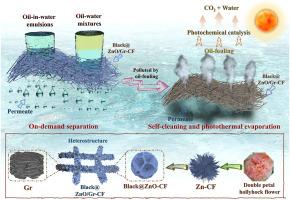Black@ZnO/Gr modified carbon fiber self-cleaning membrane for Resource Disposal of degreasing wastewater
IF 9
1区 工程技术
Q1 ENGINEERING, CHEMICAL
引用次数: 0
Abstract
Membranes used for the advanced treatment of oily wastewater are susceptible to limitations, including the adhesion of oil-fouling and the residues (ions, emulsifiers, and residual oil droplets) in separated permeate. Here, multifunctional black zinc oxide (Black@ZnO) and graphene (Gr) modified carbon fiber (Black@ZnO/Gr-CF) membrane were prepared by electrodeposition and anodic oxidation, which realized the self-cleaning of oil-fouling and photothermal evaporation of separated permeate. The hierarchical micro-nano rough structure formed by stacked Gr and nanoflower-like Black@ZnO endowed Black@ZnO/Gr-CF with underwater superoleophobicity (154.0°), thereby realizing efficient separation performance in oil-water mixture and (99.8 % and 146882.3 L m−2 h−1) and emulsion (99.5 % and 27853.7 L m−2 h−1). Additionally, the reduced band gap (2.45 eV) of Black@ZnO/Gr enabled Black@ZnO/Gr-CF photocatalytic self-cleaning performance for oil-fouling, resulting in a separation efficiency recovery rate (SERR) of 95.6 % and a flux recovery rate (FRR) of 99.0 %. Moreover, the evaporation rate of Black@ZnO/Gr-CF to the separated permeate reached 2.31 kg m−2 h−1, and the rejections of TOC and ions were all over 99.0 %. In addition, the Black@ZnO/Gr-CF can separate degreasing wastewaters (DGWs) from AW-Volkswagen, achieving separation efficiency of 97.5 and 75.6 %, corresponding fluxes of 6805.2 and 5255.3 L m−2 h−1, and the SERR and FRR reached 93.9 and 92.8 %. The evaporation rate of the separated permeate reached 2.19 kg m−2 h−1, and the rejections of TOC and ions were over 98.0 %. Following water impact, wear resistance, and UV aging test, the underwater oil contact angle of the Black@ZnO/Gr-CF stayed above 150.0°. Self-cleaning membranes with special wettability provide new insights into the treatment of actual DGWs.

Black@ZnO/Gr改性碳纤维自洁膜资源化处理脱脂废水
用于含油废水深度处理的膜容易受到限制,包括油污的粘附和分离渗透液中的残留物(离子、乳化剂和残余油滴)。通过电沉积和阳极氧化制备了多功能黑色氧化锌(Black@ZnO)和石墨烯(Gr)改性碳纤维(Black@ZnO/Gr- cf)膜,实现了油垢的自清洁和分离渗透液的光热蒸发。由Gr和纳米花状Black@ZnO叠加形成的分层微纳粗糙结构赋予Black@ZnO/Gr- cf具有水下超疏油性(154.0°),从而实现了油水混合物(99.8%和146882.3 L m−2 h−1)和乳化液(99.5%和27853.7 L m−2 h−1)的高效分离性能。此外,Black@ZnO/Gr的带隙减小(2.45 eV)使Black@ZnO/Gr- cf对油污的光催化自清洁性能得以实现,分离效率回收率(SERR)达到95.6%,通量回收率(FRR)达到99.0%。Black@ZnO/Gr-CF对分离膜的蒸发速率达到2.31 kg m−2 h−1,TOC和离子的去除率均在99.0%以上。Black@ZnO/Gr-CF对AW-Volkswagen脱脂废水的分离效率分别为97.5%和75.6%,分离通量分别为6805.2和525.3 L m−2 h−1,SERR和FRR分别为93.9%和92.8%。分离后的渗透液蒸发速率达到2.19 kg m−2 h−1,TOC和离子的去除率达到98.0%以上。经过水冲击、耐磨性和UV老化试验,Black@ZnO/Gr-CF的水下油接触角保持在150.0°以上。具有特殊润湿性的自清洁膜为实际DGWs的处理提供了新的见解。
本文章由计算机程序翻译,如有差异,请以英文原文为准。
求助全文
约1分钟内获得全文
求助全文
来源期刊

Journal of Membrane Science
工程技术-高分子科学
CiteScore
17.10
自引率
17.90%
发文量
1031
审稿时长
2.5 months
期刊介绍:
The Journal of Membrane Science is a publication that focuses on membrane systems and is aimed at academic and industrial chemists, chemical engineers, materials scientists, and membranologists. It publishes original research and reviews on various aspects of membrane transport, membrane formation/structure, fouling, module/process design, and processes/applications. The journal primarily focuses on the structure, function, and performance of non-biological membranes but also includes papers that relate to biological membranes. The Journal of Membrane Science publishes Full Text Papers, State-of-the-Art Reviews, Letters to the Editor, and Perspectives.
 求助内容:
求助内容: 应助结果提醒方式:
应助结果提醒方式:


